Extra Virgin Olive Oil: Not So Virgin
Studies on the Mediterranean Diet have shown that extra virgin olive oil (EVOO) is one of the healthiest culinary fats on the planet. EVOO is high in polyphenols that provide anti-inflammatory and antioxidant effects in our bodies and for the oil itself. EVOO offers protection for the heart, gut, brain and some studies show it provides protection from cancer. This has lead medical researchers, nutritionists and other health professionals to recommend it as one of the top fats for cooking and other food prep.
But, what if the extra virgin olive oil you are using is not quite that – virgin? Extra virgin olive oil comes from the first press of the olives and is free of additives. It is considered “Liquid Gold.” A recent 60 Minutes report highlighting millenniums-old olive oil fraud revealed that a large percentage (75% - 80%) of the EVOO sold in the US has been adulterated with cheap seed oils, chlorophyll and sometimes even solvents and pesticides. Experts in the olive oil industry say that EVOO is a very lucrative business, 3 times more lucrative than cocaine. So, like any other valuable commodity, greed can breed dishonesty.75-80% of EVOO sold in the US has been adulterated with cheap seed oils and more. #saslife Click To Tweet
If you missed it, you can read the 60 Minutes report about EVOO here.
So, what can we do to avoid falling victim to EVOO fraud?
Most importantly, know the actual source of the EVOO you are buying. Also, be aware that really cheap EVOO (< $10 per liter) is likely not 100% virgin olive oil or high quality EVOO. But, this doesn’t mean you have to pay a fortune for great olive oil. Tom Mueller, author of the book, Extra Virginity: The Sublime and Scandalous World of Extra Virgin Olive Oil, provides a continually evolving list of recommended pure EVOO’s and their sources on his website Truth In Olive Oil.
In addition, Consumer Labs is performing an independent test of EVOOs which will be published in Spring 2016. Stay tuned to this blog as we will provide the results of the Consumer Labs report as soon as it is available.
In the meantime, here are some quick tips to make sure your precious dollars are buying the real deal.
What to look for when buying high quality EVOO
- Make sure it is from a reputable source that has been tested in a certified lab for purity. Find a quality EVOO store/supplier in your town or community.
- Look for a supplier or store that lists the FFA (free fatty acid) and polyphenol content of the oils. Polyphenol content can range from <100 up to 800 ppm. The higher the polyphenol number the more health benefits, however, oils with polyphenol levels >400 may be too bitter or peppery for some taste buds. A polyphenol content of around 300 – 400 and an FFA level of <0.2 is considered very good.
- Like most oils, EVOO goes rancid with age. Look for bottles that list a “date of harvest” and try to buy oil from this year’s harvest. If a “date of harvest” is not listed, look for a ”best by” date. According to Tom Mueller, “best by” dates are usually within 2 years of the bottling date. Buy as close to the bottling date as possible.
- Buy oil in dark colored glass bottles to protect it from light.
- Notice how it was stored in the store where you purchase it. Example: Is it stored in clear (not dark) glass or plastic bottles in bright light next to a window? Or, is it stored in “fustis” (foos’-tees) which are mini stainless steel vessels that protect the oil from light and heat?
- If possible, buy from a source where you have the opportunity to taste it before you buy.
- Buy a quantity you will use up quickly. Oil sitting under a large amount of oxygen in a half used bottle can go rancid more quickly.
For more info on how to buy great olive oil, click here.
Sources of truly “virgin” EVOO
You can find Tom Mueller’s EVOO Recommendations From North America here and his Supermarket EVOO Recommendations here.
If you live in the Triangle area of North Carolina, you can purchase top shelf EVOO at several extra virgin olive oil stores supplied by Veronica Foods of California (one of Tom Mueller’s recommended suppliers). Stop in one of these stores for a fun and unique tasting experience:
- Peak Olive Oil and Vinegar, Cary, NC
- Midtown Olive Oil and Vinegar, Raleigh, NC
- Blue Sky Olive Oil and Vinegar, Chapel Hill, NC
How to Store EVOO
So, you’ve invested in primo EVOO, here’s how to protect it once you get it home.
Protect EVOO from its 3 enemies – light, heat and oxygen:
- Store it in a cool, dark place like a pantry or cabinet with a solid door.
- Store it with an air tight lid to keep oxygen out.
- Store it away from heat (don’t leave it on the counter next to your stove).
Tips for Cooking with EVOO
In spite of what you may have heard about EVOO’s low smoke point, olive oil experts state that the polyphenols and high levels of monounsaturated fatty acids in high quality EVOO protect the oil against oxidation when heated. EVOO can safely be used in low to medium heat cooking and even in higher heat cooking for short term applications like stir fries.
Try these tips from cookbook author and chef, Rebecca Katz when cooking with EVOO:
- Heat your pan first.
- Add EVOO and allow it to heat until it shimmers. This is when to add your food.
- Once you add the food, the smoke point drops precipitously.
- According to Chef Katz, if you follow these guidelines, you would have to be working at an industrial-sized range with considerably higher heat capabilities to exceed the smoke point for EVOO.
- EVOO is safe to use for oven roasting. This is indirect heat so it does not present a risk of reaching EVOO’s smoke point.
For more information about the virtues of Extra Virgin Olive Oil, check out these sources:
Roasted Spiralized Summer Squash
Serves 6

My intention when I first started making spiralized squash noodles was to use them as a replacement for pasta since my hubby and I eat a lower carb diet these days. I got the idea one day to roast them and they were so delicious they’ve never once made it to the pasta sauce. Roasted squash noodles are one of our favorite side dishes! They are super quick and simply delectable!
Ingredients
4 zucchini
4 yellow squash
2 – 3 Tbsp extra virgin olive oil
½ tsp homemade Lawry’s seasoned salt (see recipe below) or sea salt
½ tsp black pepper
Directions
- Preheat oven to 400ºF.
- Spiralize the zucchini and yellow squash. Lay the “squash noodles” out on paper towels to drain some of the moisture.

- Line 2 large baking sheets with parchment paper. Pile half of the squash noodles in the center of each baking sheet.
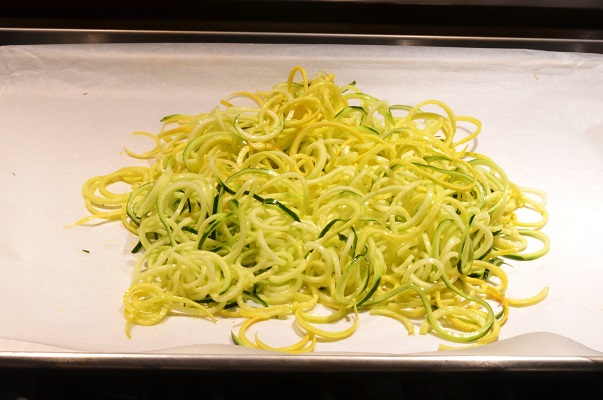
- Drizzle half the EVOO on each pile. Toss to evenly coat the squash noodles.
- Spread squash noodles evenly in a single layer on each baking sheet. Add salt and pepper to taste.
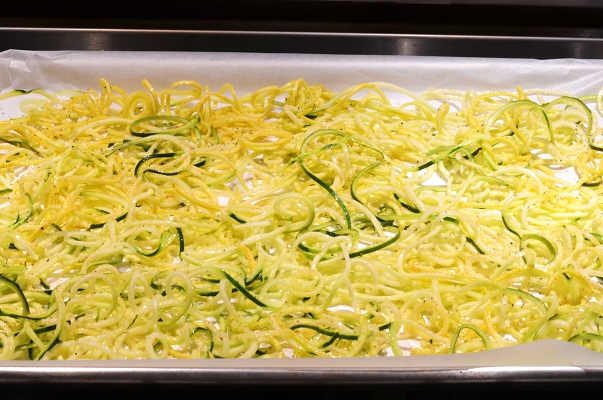
- Roast at 400ºF for 20–25 minutes rotating pans 180º half way through cooking cycle. Depending on your oven, you may need to toss the squash noodles around to make sure they cook evenly.
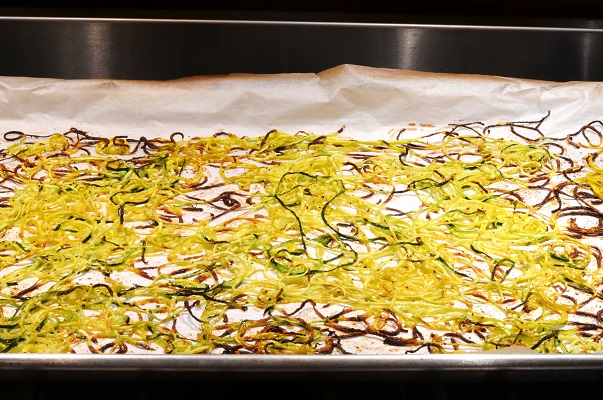
- Serve as a side dish or under your favorite pasta sauce.
A few notes about how to make perfectly roasted vegetables:
- If you like a crunchy end product, vegetables need plenty of breathing room when roasting. If crowded, they will steam and get soft instead of getting crispy and golden brown. Be sure to use a large baking sheet or two to allow vegetables to be in a single layer with spacing in between.
- Also for great crunch, a baking pan with shallow sides is preferable over a baking casserole dish with taller sides. With taller sides, the steam from the vegetables stays trapped in the dish making the vegetables soggy. Shallow sides allow the steam to escape creating crispier vegetable bites.
- Wash vegetables and allow them to completely air dry before tossing them with oil. If vegetables are wet, the olive oil will not coat them well so your end result will not be as crispy. Cook’s Note: I wash my vegetables on weekends, let them air dry on paper towels, then store them in the fridge until ready for use. This way, they are good to go when I’m ready for them.
Homemade Lawry’s® Seasoned Salt
Makes 124 Servings
Adapted from: allrecipes.com
This homemade recipe for Lawry’s® Seasoned Salt is just as delicious as the store-bought version but is made with your own clean spices. It eliminates the corn starch and oleoresin paprika (contains hexane) used to color Lawry’s. It also contains sea salt instead of table salt.
Ingredients
2 Tbsp sea salt
1 ½ tsp paprika
1 tsp turmeric
½ tsp onion powder
½ tsp garlic powder
Directions
- Mix all ingredients thoroughly with a mortar and pestle (makes it a finer blend) or whisk together in a bowl.


- Store in an air-tight container or an old spice bottle with a shaker lid.
Click here for a printer-friendly version of the Homemade Lawry's and Spiralized Squash recipes.
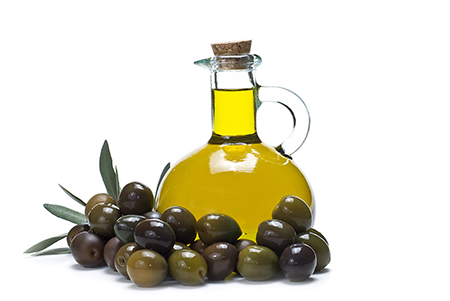
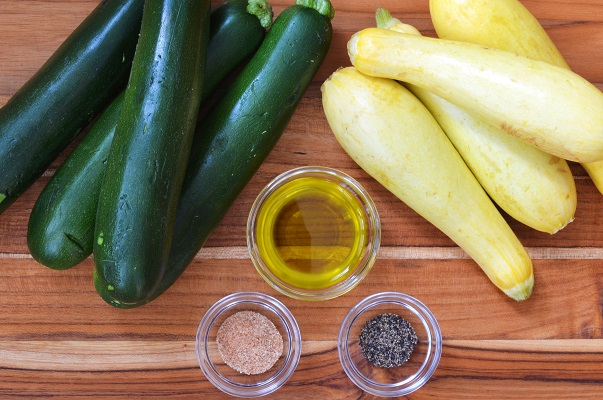
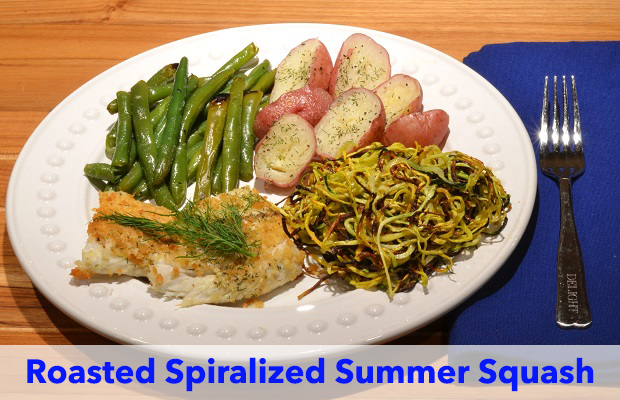

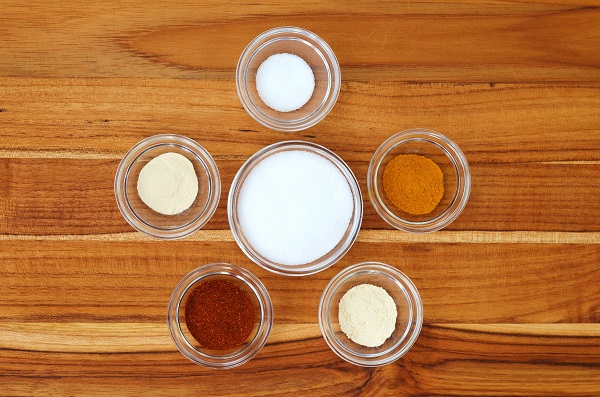

4 Comments
Hello Cathy,
This is a subject that is quite dear to me. I'm from Portugal and besides working at SAS I'm also a small farmer and producer of Olive Oil (so far just for my own family consumption)
I also saw the 60 minutes and indeed falsifications seem to be a problem.
It seems that in US you are paying too much for those high-brands, but besides them there are wonderful local producers much cheaper and above all made by the farmers themselves in local communities without any kind of falsifications.
Regards,
Ricardo
Hi Ricardo,
Thanks so much for your post. How wonderful that you can grow and produce your own olives/olive oil!
I agree that high quality olive oil in the US seems overpriced. Thanks for the reminder about buying local. We don't have many states in the US that produce olive oil but your comment motivates me to connect with the California Olive Oil Industry and get to know some farmers and producers there. And, when you say local, you may mean "your" local. Since you dabble in the EVOO industry, is there a network of trustworthy "locally grown" olive oil producers that we can tap into to help us get to know the EVOO farmers and producers from other countries? Many people, myself included, would much prefer knowing and supporting a "local' EVOO farmer/producer.
Cathy
Hi Cathy,
Thanks so much for this writing and many I am so looking forward to reading them!...Just been crazy busy with work, that I didn't quite get a chance to go through them. I enjoyed meeting with you the other day and learnt a lot. You have a lot of useful, relevant info and tips. Going to miss you so much...
Good Luck and Enjoy Your "Free" time 🙂
Thanks!
Thank you, Sujatha! And, bless you. It has been a pleasure knowing you. 🙂